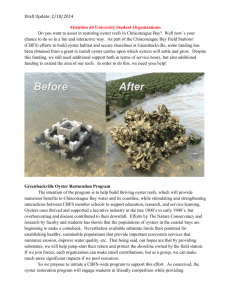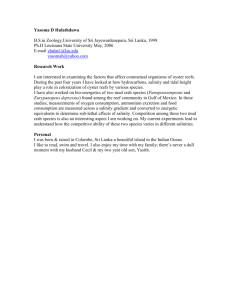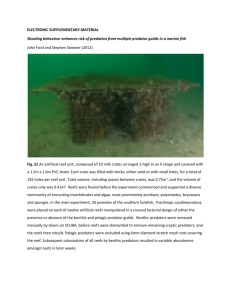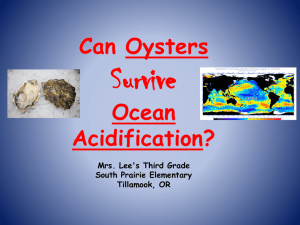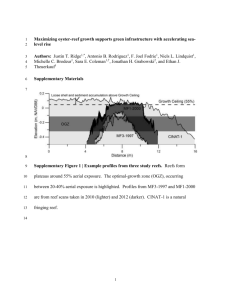Casas, S.M. - South Carolina Sea Grant Consortium
advertisement
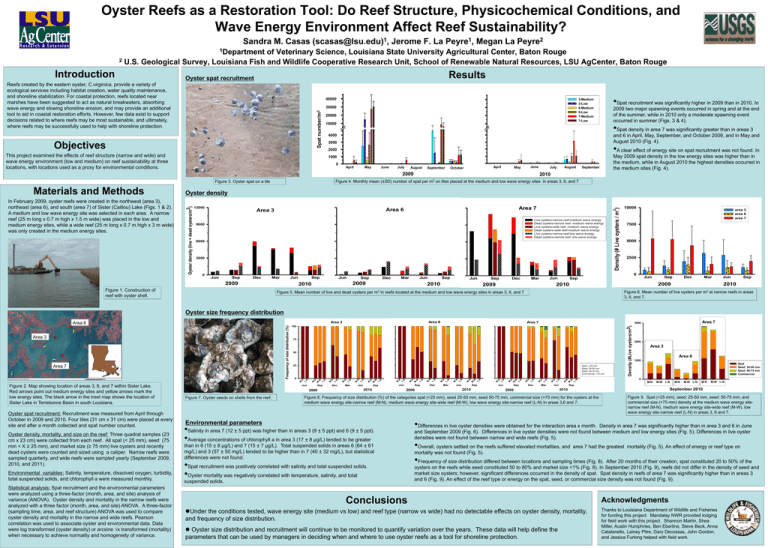
Oyster Reefs as a Restoration Tool: Do Reef Structure, Physicochemical Conditions, and Wave Energy Environment Affect Reef Sustainability? Sandra M. Casas 1 (scasas@lsu.edu) , Jerome F. La 1 Peyre , Megan La 2 Peyre 1Department of Veterinary Science, Louisiana State University Agricultural Center, Baton Rouge 2 U.S. Geological Survey, Louisiana Fish and Wildlife Cooperative Research Unit, School of Renewable Natural Resources, LSU AgCenter, Baton Rouge Results Oyster spat recruitment Reefs created by the eastern oyster, C.virginica, provide a variety of ecological services including habitat creation, water quality maintenance, and shoreline stabilization. For coastal protection, reefs located near marshes have been suggested to act as natural breakwaters, absorbing wave energy and slowing shoreline erosion, and may provide an additional tool to aid in coastal restoration efforts. However, few data exist to support decisions related to where reefs may be most sustainable, and ultimately, where reefs may be successfully used to help with shoreline protection. 40000 Spat number/m2 30000 Objectives 20000 10000 •Spat density in area 7 was significantly greater than in areas 3 and 6 in April, May, September, and October 2009, and in May and August 2010 (Fig. 4). 3000 •A clear effect of energy site on spat recruitment was not found. In 2000 May 2009 spat density in the low energy sites was higher than in the medium, while in August 2010 the highest densities occurred in the medium sites (Fig. 4). 1000 0 April May June July August September April October June May July 2009 August September 2010 Figure 4. Monthly mean (±SD) number of spat per m2 on tiles placed at the medium and low wave energy sites in areas 3, 6, and 7 Figure 3. Oyster spat on a tile Oyster density 12000 Area 7 Area 6 Area 3 2 Oyster density (live + dead oysters/m2) In February 2009, oyster reefs were created in the northwest (area 3), northeast (area 6), and south (area 7) of Sister (Caillou) Lake (Figs. 1 & 2). A medium and low wave energy site was selected in each area. A narrow reef (25 m long x 0.7 m high x 1.5 m wide) was placed in the low and medium energy sites, while a wide reef (25 m long x 0.7 m high x 3 m wide) was only created in the medium energy sites. 2009 two major spawning events occurred in spring and at the end of the summer, while in 2010 only a moderate spawning event occurred in summer (Figs. 3 & 4). 4000 This project examined the effects of reef structure (narrow and wide) and wave energy environment (low and medium) on reef sustainability at three locations, with locations used as a proxy for environmental conditions. Materials and Methods •Spat recruitment was significantly higher in 2009 than in 2010. In 3-Medium 3-Low 6-Medium 6-Low 7-Medium 7-Low Live oysters-narrow reef-medium wave energy Dead oysters-narrow reef -medium wave energy Live oysters-wide reef -medium wave energy Dead oysters-wide reef-medium wave energy Live oysters-narrow reef-low wave energy Dead oysters-narrow reef -low wave energy 9000 6000 3000 0 Jun Sep Dec Mar Jun 2009 Figure 1. Construction of reef with oyster shell. Sep Jun Sep Mar Dec Jun 2009 2010 Density (# Live oysters / m ) Introduction 10000 area 3 area 6 area 7 7500 5000 2500 0 Sep Jun Sep 2010 Dec Jun Mar Jun Sep Dec Mar 2009 2010 2009 Sep Jun Sep 2010 Figure 6. Mean number of live oysters per m2 at narrow reefs in areas 3, 6, and 7. Figure 5. Mean number of live and dead oysters per m2 in reefs located at the medium and low wave energy sites in areas 3, 6, and 7 Oyster size frequency distribution 25 Oyster spat recruitment: Recruitment was measured from April through October in 2009 and 2010. Four tiles (31 cm x 31 cm) were placed at every site and after a month collected and spat number counted. Oyster density, mortality, and size on the reef: Three quadrat samples (23 cm x 23 cm) were collected from each reef. All spat (< 25 mm), seed (75 mm < X ≥ 25 mm), and market size (≥ 75 mm) live oysters and recently dead oysters were counted and sized using a caliper. Narrow reefs were sampled quarterly, and wide reefs were sampled yearly (September 2009, 2010, and 2011). Environmental variables: Salinity, temperature, dissolved oxygen, turbidity, total suspended solids, and chlorophyll a were measured monthly. Statistical analysis: Spat recruitment and the environmental parameters were analyzed using a three-factor (month, area, and site) analysis of variance (ANOVA). Oyster density and mortality in the narrow reefs were analyzed with a three factor (month, area, and site) ANOVA. A three-factor (sampling time, area, and reef structure) ANOVA was used to compare oyster density and mortality in the narrow and wide reefs. Pearson correlation was used to associate oyster and environmental data. Data were log transformed (oyster density) or arcsine √x transformed (mortality) when necessary to achieve normality and homogeneity of variance. Jun Dec Mar Jun Sep 2010 Sep 2009 Dec Mar Jun Sep 2010 Jun Sep Dec Mar Jun 2009 LN -W M -N M -N LN M LN -N M LN -N M LN -W M -N M -N LN M N L- -W M -N M N L- -N M N L- -N M N L- -N M N L- -W M Jun M -N N L- -N M N L- -W M M -N N L- -N M N L- -N M N L- -N M N Sep 2009 Figure 7. Oyster seeds on shells from the reef. L- -W M -N M L- N Spat: < 25 mm Seed: 25-50 mm Seed: 50-75 mm Commercial: >75 mm •Salinity in area 7 (12 ± 5 ppt) was higher than in areas 3 (9 ± 5 ppt) and 6 (9 ± 5 ppt). •Average concentrations of chlorophyll a in area 3 (17 ± 8 µg/L) tended to be greater than in 6 (15 ± 8 µg/L) and 7 (15 ± 7 µg/L). Total suspended solids in areas 6 (64 ± 61 mg/L) and 3 (57 ± 50 mg/L) tended to be higher than in 7 (40 ± 32 mg/L), but statistical differences were not found. •Spat recruitment was positively correlated with salinity and total suspended solids. •Oyster mortality was negatively correlated with temperature, salinity, and total suspended solids. 2000 Area 3 Area 6 1000 Spat Seed: 25-50 mm Seed: 50-75 mm Commercial 0 M-N M-W L-N M-N M-W L-N M-N M-W L-N Sep September 2010 2010 Figure 8. Frequency of size distribution (%) of the categories spat (<25 mm), seed 25-50 mm, seed 50-75 mm, commercial size (>75 mm) for the oysters at the medium wave energy site-narrow reef (M-N), medium wave energy site-wide reef (M-W), low wave energy site-narrow reef (L-N) In areas 3,6 and 7. Environmental parameters Density (#Live oysters/m2) 50 0 Area 7 3000 75 M Area 7 Area 7 100 -N Frequency of size distribution (%) Area 3 Figure 2. Map showing location of areas 3, 6, and 7 within Sister Lake. Red arrows point out medium energy sites and yellow arrows mark the low energy sites. The black arrow in the inset map shows the location of Sister Lake in Terrebonne Basin in south Louisiana. Area 6 Area 3 Area 6 Figure 9. Spat (<25 mm), seed: 25-50 mm, seed: 50-75 mm, and commercial size (>75 mm) density at the medium wave energy sitenarrow reef (M-N), medium wave energy site-wide reef (M-W), low wave energy site-narrow reef (L-N) in areas 3, 6 and 7. •Differences in live oyster densities were obtained for the interaction area x month. Density in area 7 was significantly higher than in area 3 and 6 in June and September 2009 (Fig. 6). Differences in live oyster densities were not found between medium and low energy sites (Fig. 5). Differences in live oyster densities were not found between narrow and wide reefs (Fig. 5). •Overall, oysters settled on the reefs suffered elevated mortalities, and area 7 had the greatest mortality (Fig. 5). An effect of energy or reef type on mortality was not found (Fig. 5). •Frequency of size distribution differed between locations and sampling times (Fig. 8). After 20 months of their creation, spat constituted 20 to 50% of the oysters on the reefs while seed constituted 50 to 80% and market size <1% (Fig. 8). In September 2010 (Fig. 9), reefs did not differ in the density of seed and market size oysters; however, significant differences occurred in the density of spat. Spat density in reefs of area 7 was significantly higher than in areas 3 and 6 (Fig. 9). An effect of the reef type or energy on the spat, seed, or commercial size density was not found (Fig. 9). Conclusions Under the conditions tested, wave energy site (medium vs low) and reef type (narrow vs wide) had no detectable effects on oyster density, mortality, and frequency of size distribution. Oyster size distribution and recruitment will continue to be monitored to quantify variation over the years. These data will help define the parameters that can be used by managers in deciding when and where to use oyster reefs as a tool for shoreline protection. Acknowledgments Thanks to Louisiana Department of Wildlife and Fisheries for funding this project. Mandalay NWR provided lodging for field work with this project. Shannon Martin, Shea Miller, Austin Humphries, Ben Eberline, Steve Beck, Anna Catalanello, Lainey Pitre, Gary Decossas, John Gordon, and Jessica Furlong helped with field work.
